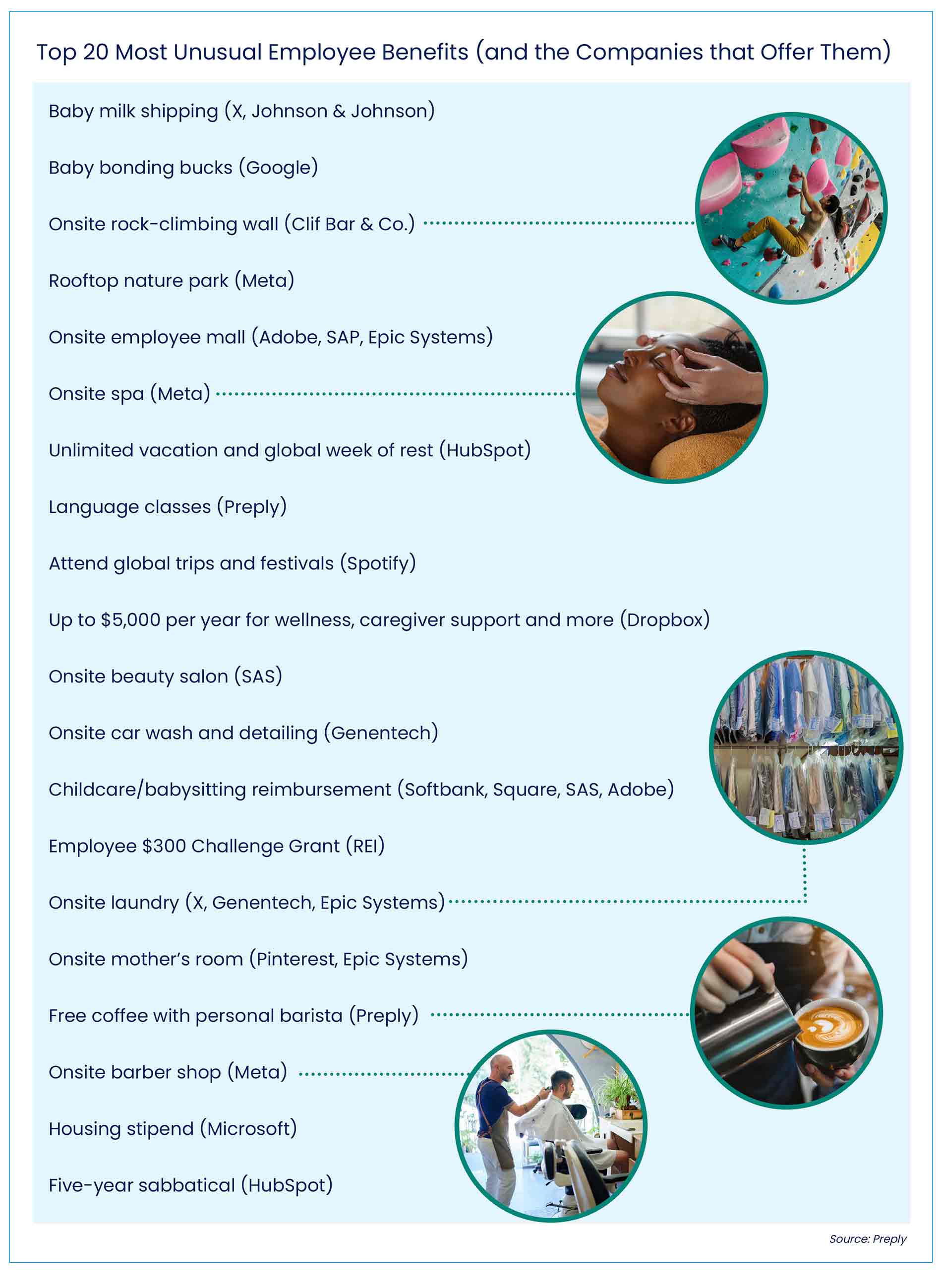- Think outside the box. Some organizations now offer employees novel benefits such as baby milk delivery service, onsite climbing walls and beauty salons to attract and retain talent.
- Consider the success stories. Some of those organizations report a lower employee turnover rate compared to the other companies.
- Connect with the workforce. Offering unique onsite benefits can be vital in helping workers return to the office, create camaraderie and experience the company culture.
Do your employee benefits include unlimited vacation, access to a spa or coffee service from an onsite barista? Perhaps, you should consider it.
New research from online tutoring platform Preply has not only uncovered what companies currently offer the most nontraditional — and, in some cases, unusual— employee benefits, but also a correlation between those benefits and a positive impact on bottom-line metrics such as employee turnover rate.
Some of the more unusual benefits identified by Preply was baby milk shipping for new parents, offered at employers like X (formerly Twitter) and Johnson & Johnson, and Google’s “baby bonding bucks,” which is a monthly stipend for new parents to spend on items like meal delivery or cleaning services (see graphic below).

Looking at the top 10 companies in the study, Preply found, on average, those organizations had a lower employee turnover rate (11.91%) compared to other listed companies (14.70%), suggesting employers that invest in innovative benefits programs are more likely to retain their talent by boosting employee satisfaction.
Webinar: Winning Talent with Global Benefits and Total Rewards
“Companies may lose sight of why benefits packages are so important to a company’s growth, but it’s simple,” said Andreas Kyprianou, Preply’s senior director of people operations, total rewards and analytics. “Top performers drive tangible business impact, and they’re going to go where they feel most appreciated and taken care of.”
Return-to-Office Tactics?
Many of the nontraditional benefits found on Preply’s list are geared toward onsite staffers. Could they be part of a larger trend designed to encourage more people to return to the office?
Chris Caraher, director of strategic partnerships for voluntary benefits at Gallagher, thinks so. He noted that employers offering unorthodox perks may lessen the stress of commuting to the office and working set hours, as well as move the needle on creating or bolstering a company’s culture.
“The nontraditional benefits — such as onsite gym facilities, day care, wellness activities or happy hours — are an extension of the culture the organization is curating,” Caraher explained. “A key aspect of returning to the office is team-building and fostering the culture, so there can be a real benefit to offering these benefits.”
But according to OneDigital internal research, post-pandemic onsite perks targeted toward convenience are generally not valued in the same way as providing very specific personalized benefits, said Joanna Evans, a senior benefits consultant at that company.
“Flexibility is highly valued, and we are not seeing onsite perks that really support employers’ return-to-work efforts,” she said.
Results May Vary
So, just how effective are these nontraditional types of benefits for an organization?
Depending on the industry and the type of employees that organizations are trying to attract or retain, these benefits can pay dividends, Caraher said.
He suggests organizations first do their due diligence before offering anything novel. “We find that before organizations look at adding nontraditional benefits, they should make sure their core benefits are in line with their industry peers,” Caraher said.
To that end, there is a trend in benefits happening right now toward personalization, Evans said.
“It’s even more important for younger generations entering the workforce to feel like the benefits are meeting their specific needs and not generalized,” she said. “Therefore, benefits like baby milk shipping or family-forming benefits that cater to specific individualized needs are highly valued and effective.”
Fitting Into Total Rewards
Nontraditional benefits can fit into an organization’s total rewards package by standing out, said Evans.
“Part of the goal of nontraditional benefits is to meet specific, personalized needs that individuals have,” she said. “Nontraditional benefits are meant to support the whole spectrum of an individual’s well-being — whether that be emotional, social, financial, environmental or physical.”
In today’s economy, employees are often worried about deductibles and copays on their core benefits. Therefore, it’s important to have a strong core package with a solid communication strategy to make sure they understand their benefits.
“You can offer all of the benefits under the sun, but if your employees don’t know about them or don’t understand how they work, then they aren’t appreciated and can lead to lower employee satisfaction and turnover,” Caraher said.
Evans also noted nontraditional employee benefits such as climbing walls, unlimited vacation and laundry services are offered to keep up with the competition.
“If companies in a certain industry usually offer family-forming benefits, for example, we see others following suit as a way to maintain competitiveness in attracting and retaining top talent,” she said.
Some nontraditional benefits are very meaningful to prospective employees and will influence their decision to work for a company, Evans said, “but generally, core benefits will still be measured the most.”
(See how nontraditional benefits play a role in total rewards by viewing WorldatWork’s Inventory of Programs and Practices.)
Editor’s Note: Additional Content
For more information and resources related to this article, see the pages below, which offer quick access to all WorldatWork content on these topics:







